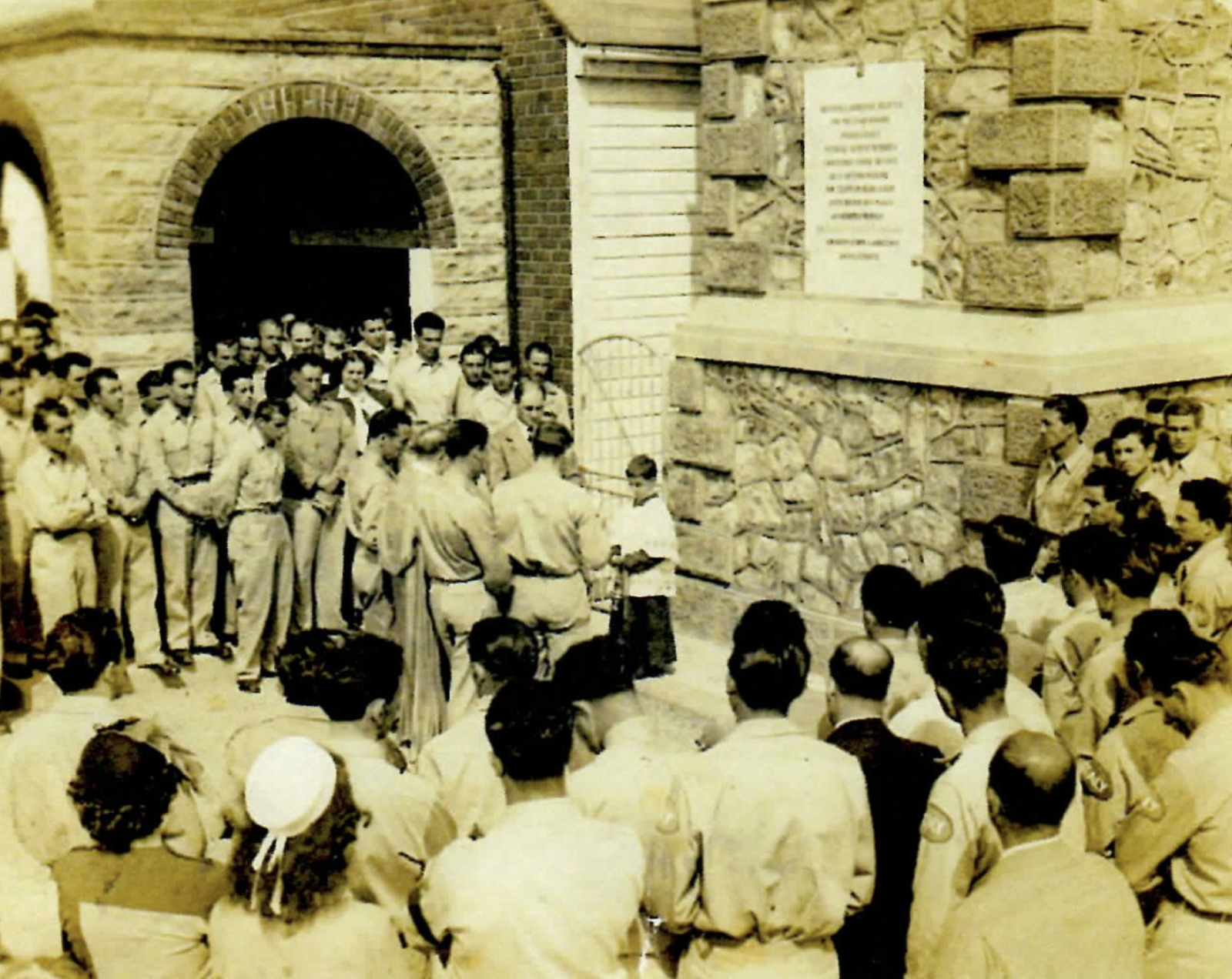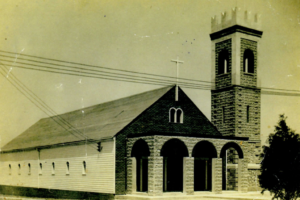While the location—a little more than 10 miles from the Mason-Dixon Line—might not immediately spring to mind when thinking of areas of historic Italian American significance, the grounds of the Letterkenny Army Depot tell a much different story.
During World War II, the United States government interned more than 1,200 captured Italian soldiers at Letterkenny. From May 1944 to October 1945, these soldiers became part of the 321st Italian Quartermaster Battalion, originally commanded by Lt. Col. Salvatore Campa and then by Maj. Angelo Bassi. The 321st was then divided into six Italian Service Units (ISUs) that provided assistance at the new Depot.
Letterkenny Army Ordinance Depot, as it was then known, was one of the nation’s largest and newest military depots by the time the Italian POWs arrived. It was constructed out of 20,000 acres of farmland just a few years prior in 1942. Letterkenny contained 30 warehouses and 800 underground storage units that held munitions, weapons, and other military equipment that was then packaged and sent to Europe and to the Pacific. Working side-by-side with Americans, the Italian POWs collaborated with the United States to help defeat Axis powers and left their mark on both the Depot and the surrounding area.
This article first appeared in La Nostra Voce, ISDA’s monthly newspaper that chronicles Italian American history, culture and traditions. Subscribe today.
“Because of different regulations based on the Geneva Convention Accords, we had to provide our POWs the same amount of rations and medical care as we gave our own troops, and provide them similar living quarters,” explained Alan R. Perry, PhD, the chair of the Department of Italian Studies at Gettysburg College and co-author, along with Flavio G. Conti, of several books outlining the Italian POW experience in Pennsylvania. “Our troops were treated uniformly better than any other nation in the world. If you were taken prisoner by the United States, you were treated very, very well.”
In the case of the Letterkenny POWs, the men were afforded freedoms that helped them integrate into American, as well as Italian American, life during their internment. These freedoms included the ability to receive visitors, as well as to travel off base to heavily Italian-populated places, such as Philadelphia.
“The Italian American communities really responded to having the POWs nearby, they saw them as a point of reference that was deeply meaningful to them and they felt compelled to reach out to them,” Perry said. “Many Italian American families would take a Sunday drive to Letterkenny—some traveling several hours at a time—just to visit the POWs. It was one of the ways that the Italian Americans reinforced their own identity, their sense of Italianness. They were Americans, but they did not forget where they came from, and that was revalidated through the care they offered to the Italian POWs.”
While the POWs were embraced by the Italian American community, they also embraced their life at the young Depot, as is evinced in the buildings they helped create that still stand today, such as the chapel, bell tower, and assembly hall. The POWs also constructed an amphitheater, which has since been torn down.
Adding to the deep emotional ties surrounding the Italian POW experience at Letterkenny is the lore that can be sensed today in the remaining structures, most particularly at the Letterkenny Army Depot’s Chapel. At the beginning of 1945, the United States command had the POWs begin to construct a chapel to be used exclusively as a place of worship. Popular tradition holds that the depot commander at the time, Colonel Ray M. Hare, discovered that one of the Italian POWs had learned of his wife’s death in Italy and that the despondent POW was about to commit suicide.
According to Perry and Conti’s research, the POW in question was most likely Sgt. Maj. Giuliano Orzali, a Tuscan master mason who was at Letterkenny at the time. Col. Hare assigned the construction of the chapel to the POW to help him channel his grief. Another Italian POW, 2LT Marcello Iovine, oversaw Orzali and a dedicated building crew. Using materials salvaged from abandoned farmhouses on post, the Chapel was built at no expense to the United States government and was consecrated on May 13, 1945. It is the only chapel of its kind in the United States.
“We built this church with our bare hands and faith in God,” said the late Alfred Tonolo, one of the POWs who helped build the chapel during a rededication ceremony in 2003 after it was acquired by The United Churches of the Chambersburg Area. Tonolo met his wife, Tina Norce, while at Letterkenny when her family traveled roughly 150 miles from their home in Berwick, Pennsylvania, one Sunday to visit the POWs. They corresponded for four years after the war and were married in Italy in 1949. Tonolo eventually earned his doctoral degree and served on the faculty of Bloomsburg University for nearly 30 years.
Following World War II, the Commonwealth of Pennsylvania placed the Letterkenny Chapel on its Register of Historic Places. Today, the Historic Letterkenny Chapel and Franklin County Veterans and 9/11 Memorial Park oversees its upkeep.
The Chapel itself was the site of a 2015 Mass commemorating the 70th anniversary of the Letterkenny POW repatriation to Italy, organized by Perry and Conti. Several children and grandchildren of former Italian POWs attended the Mass. The reunion of the POW descendants drove home the necessity to continue telling the POW story and in 2016, the Italy-based Associazione per la Memoria dei Prigionieri Italiani a Letterkenny (A.M.P.I.L.) was formed.
Antonio Brescianini, whose father Luigi was interned at Letterkenny, served as the president of A.M.P.I.L. from its inception until 2020. Brescianini served as the mayor of Vimodrone, near Milan, in 2014 and had access to the list of former Letterkenny POWs. Through his search, he has been able to connect with roughly 600 families.
“This search brought out emotions and memories of loved ones,” he said. “Many people go in search of photographs, documents to bring to light the memories they have heard about their loved ones in life.”
Brescianini, along with 23 other family members of former POWs, attended the 2015 Mass.
“This Mass helped strengthen the friendly relations between our peoples,” he said. “The Chapel was built with love by our fathers with devotion to God, thanking Him for the mercy He had during the war period. A piece of the Twin Towers has been placed next to the small church nicknamed the “Church of Peace” in recent years, meaning that the peace and love our prisoners were shown in Letterkenny always prevails over evil.”
Although all the former POWs have now passed on, their children and grandchildren keep their memory alive through A.M.P.I.L. In September 2022, a group visited the Letterkenny Chapel for the 75th anniversary of repatriation. The visitors brought many gifts from Italy to thank the community for the kindness shown to the POWs so many years ago, including artwork by Aldo Mazzantini, whose father, Amilcare, was a POW at Letterkenny. Mazzantini created a sculpture of “The Deposition” of Jesus into Mary’s arms following His crucifixion that was installed at Corpus Christi Church in Chambersburg in thanksgiving for the church’s pastoral ministry to the POWs during their detainment. Carlo Borghetti, the vice president of the Region of Lombardy, performed an organ concert before a commemorative Mass in memory of the POWs at Corpus Christi Church.
“This animated force of love is still deeply lived and appreciated by the children and grandchildren of these soldiers,” Perry said. “These Italian POWs actively helped to defeat Nazi Germany. That’s an important story, but it’s not really known. It’s not celebrated adequately enough. Its importance is only just coming out now.”
For more information on the Letterkenny Army Depot, visit https://www.letterkenny.army.mil/. To learn more about A.M.P.I.L., visit https://www.ampil.it.
Further Reading:
Italian Prisoners of War in Pennsylvania: Allies on the Home Front, 1944–1945 by Flavio G. Conti and Alan R. Perry.
World War II Italian Prisoners of War in Chambersburg by Flavio G. Conti and Alan R. Perry.
Stephanie Longo is the Associate Producer of the Italian American Podcast and the author of three books on northeastern Pennsylvania’s Italian heritage. Learn more about her at www.stephanielongowriter.com.
Make the pledge and become a member of Italian Sons and Daughters of America today.



